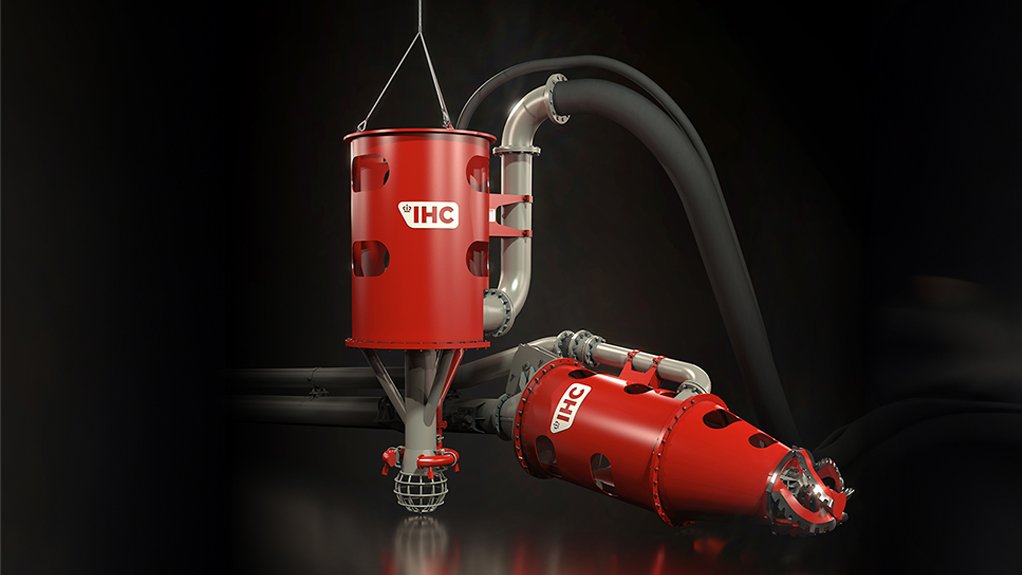The OTTer-pump, developed by maritime technology supplier Royal IHC, which is present in the dredging, offshore, mining and defence industries, presents a versatile and efficient solution for dredging operations across various sectors.
The OTTer-pump is designed for diverse applications, including commercial dredging such as heavy mineral sands mining, and maintenance activities such as tailings rehandling operations, explains IHC South Africa products manager Schalk van Zyl.
The modular design of the OTTer-pump supports interchangeable heads for tasks such as handling compacted or loose materials, while its high production rates and adaptability make it ideal for mining operations, as well as efficiently collecting and transporting material through pipelines, especially in wet conditions, he says.
It also incorporates Royal IHC’s submersible dredge pump technology, which is recognised for its durability and performance in the dredging and mining industries.
The OTTer-pump also offers an option to use Royal IHC’s patented Curve impeller, which helps extend the impeller’s life span, while maintaining high efficiency, by up to 78%, says Van Zyl.
The compact design enhances suitability for confined environments, including small harbours or inland waterways.
Van Zyl emphasises that the OTTer-pump’s deployment method is just as critical as its design, with it being compatible with various application platforms, including excavators, cranes or custom setups. This allows for efficient accessibility in difficult-to-reach areas.
Onboard sensors provide real-time data on suction vacuum, discharge pressure, depth and pump speed, enabling operators to optimise dredging accuracy and efficiency.
The OTTer-crawler platform – where the pump is mounted on a small, remotely operated crawler – offers a fully submerged solution for maintenance dredging in ponds and harbours. The platform is transportable by truck, along with the necessary ancillary equipment like the hydraulic power pack and discharge pipeline.
Drive Options
The OTTer-pump is available with hydraulic and electric drive options, providing flexibility depending on project requirements.
The hydraulic version uses a diesel-driven power pack, making it ideal for remote locations where electricity is unavailable or unreliable.
“While this option incurs higher operational costs, owing to fuel use, it is often the most practical solution in remote areas,” adds Van Zyl.
The electric version – the preferred option where electricity is readily available – is powered by a submersible electric motor and controlled by a variable-speed drive.
Van Zyl notes that this version is also well suited to environmentally sensitive areas where noise from a diesel engine or the risk of fuel spills could pose a problem.
Another alternative pumping solution involves an electrically-driven power pack that uses biodegradable hydraulic oil, offering an environment-friendly solution.
Suction Efficiency
The OTTer-pump addresses the issue of blockages by featuring a large sphere passage, allowing for stones of up to one-third the diameter of the pipeline to pass through the pump without causing damage.
This design, says Van Zyl, reduces the risk of downtime caused by blockages, particularly in environments with variable soil conditions.
“The OTTer-pump’s suction properties are enhanced by the proximity of the suction mouth to the dredge pump inlet. This configuration optimises the energy used for transporting material over longer distances, improving overall efficiency.”
For inland waterway and canal rehabilitation, the OTTer-pump can be deployed using an amphibious excavator with a long-reach boom. This enables the pump to access the banks of rivers and canals – areas that are often difficult to reach. In deeper waters, the pump can be deployed from the OTTer-dredger platform using either a ladder system with a cutter head, or a vertical deployment version with a plain suction head and jetting water, he adds.
The OTTer-dredger uses a four-point mooring system, ensuring stability and manoeuvrability during dredging operations.
The dredged material can either be pumped away, into geo-bags or discharged into faster-flowing sections of the river for natural downstream transport, depending on the project requirements.
Meanwhile, Royal IHC is continuing to focus on innovations aimed at increasing efficiency and reducing downtime.
The company is also working on automation and machine learning technologies to further optimise dredging processes and ensure consistent material feed for processing plants.
Edited by: Nadine James
Features Deputy Editor
EMAIL THIS ARTICLE SAVE THIS ARTICLE
ARTICLE ENQUIRY
To subscribe email subscriptions@creamermedia.co.za or click here
To advertise email advertising@creamermedia.co.za or click here













